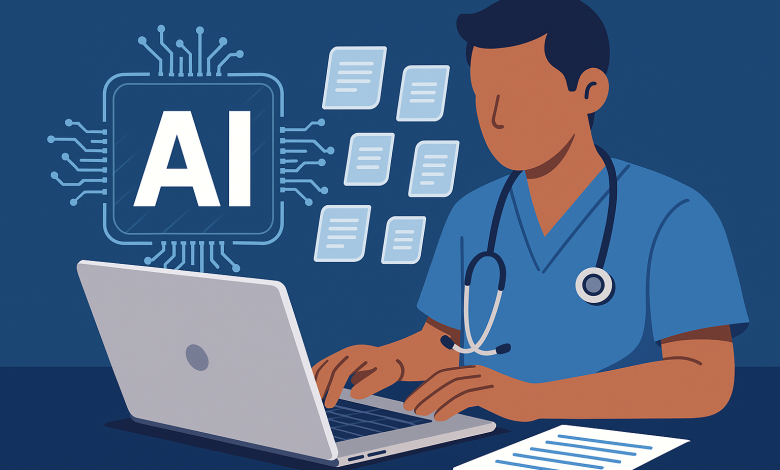
Clinicians today spend more time on screens than they do with patients. Studies show that for every hour of direct care, physicians devote nearly two to documentation, billing, and compliance tasks. What was once considered the necessary paperwork of medicine has grown into a cycle of administrative burden that drains time, energy, and focus from care.
Health systems have tried to address the problem in piecemeal ways. Some hire medical scribes. Others outsource coding. Many deploy new dashboards that sit on top of legacy systems. These approaches help at the margins, but the root problem remains: clinicians are still asked to do far too much outside the core work of treating patients.
A new approach is beginning to shift the balance. Healthcare is now beginning to work with three kinds of AI — generative, predictive, and agentic — and together they are beginning to show how technology can deliver more than marginal efficiency.
-
Generative AI creates: drafting notes, summarizing records, and preparing instructions.
-
Predictive AI forecasts: identifying patients at risk, anticipating denials, and guiding resource allocation.
-
Agentic AI acts: stepping in autonomously to complete routine but essential processes such as coding encounters, preparing claims, and flagging risks.
None of these replace clinical judgment, but each can lighten the operational burden that slows the entire system down and limits the time clinicians can spend with their patients..
AI in Action
The defining feature of agentic AI is its ability to act in real time. During a patient visit, it can capture the conversation live and draft the note as it unfolds. At the end of the encounter, it applies the appropriate diagnosis and treatment codes and prepares the claim to withstand scrutiny. In the background, it monitors for risks that might otherwise trigger costly denials.
The applications differ across roles, but the principle is consistent: action in the flow of work, not after the fact. A primary care physician ends the day with charting completed. A surgical team sees cases coded accurately the first time. Administrators experience steadier revenue cycles as denials fall. Compliance officers find fewer errors to chase. Each example highlights how AI, in its different forms, relieves the pressure points that have accumulated across modern healthcare.
Human and Organizational Impact
The most immediate effect of these systems is time returned to clinicians. Even modest shifts — finishing notes before leaving the office, or spending more of a visit focused on the patient instead of the keyboard — change the experience (and outcome) of care. Over time, these gains reduce burnout and make the profession more sustainable. Surveys consistently rank administrative overload among the top reasons clinicians consider leaving medicine. Relieving that burden improves the odds that they will stay.
Patients feel the difference as well. Encounters are less rushed. Providers are more attentive. The trust that defines good care is easier to sustain when clinicians are not pulled in multiple directions.
The organizational benefits are equally important. Healthcare practices gain revenue stability through improved financial and administrative workflows. This extends to specialized sectors such as behavioral health, where behavioral health revenue solutions help providers strengthen billing accuracy, reduce denials, and maintain consistent cash flow. Compliance teams reduce risk with audit-ready documentation. Administrators face less turnover and lower recruitment costs as staff find their work more manageable. For payers and regulators, consistency in documentation and defensible claims means fewer disputes and cleaner data across the system.
These effects reinforce each other. When frontline staff feel supported, patients receive better care. When organizations face fewer denials and disputes, financial pressures ease. When oversight bodies have reliable information, standards are easier to enforce. AI adoption creates value at every level.
A Cultural Shift in Healthcare
Technology in healthcare has long carried the reputation of being a burden rather than a benefit. Electronic health records, portals, and dashboards promised transformation but often created new frustrations. This new wave of AI — from generative to predictive to agentic — represents a break from that history. By fitting into the rhythm of care and taking on responsibility for routine work, it changes the relationship between clinicians and technology.
This shift is cultural as much as technical. Adoption grows not because systems are mandated, but because people experience real relief in their daily work. A physician who feels supported tells colleagues. A department that sees smoother workflows advocates for wider deployment. Trust spreads through lived experience, not through executive directive.
Looking Ahead
Change in healthcare shows up in the details of daily work. A chart that closes on time. A claim that clears without dispute. A provider who can focus fully on a patient.
Generative, predictive, and agentic AI are beginning to make those outcomes dependable. By creating, forecasting, and acting in the flow of care, they are reducing friction across the system.
The real significance is not in what these systems promise, but in what they restore: time, clarity, and trust in the practice of medicine. That restoration is how this new wave of AI is reshaping healthcare — quietly, but decisively.




